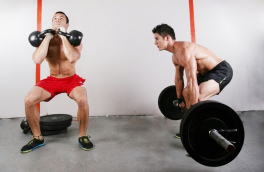Strength training through back pain
Paul Kochoa, PT, DPT, OCS, CGFI
Back pain is common. So common that I have a high confidence that inevitably, if you’re reading this, you have, or had, or will experience…. low back pain. Athletes who go through rigorous weight training regimens are just as at risk as a deconditioned couch potato.
Eventually back pain will find you. But if you’re an athlete or go to the gym and exercise regularly, what can you do to prevent a month-long rest break that may compromise any gains that you’ve attained with your exercise program? Here’s some tips.
Assess the severity and directional preference. You have to do a self check to determine a couple factors. Do you have any tingling or numbness or burning that radiates down the leg? Any loss of sensation? Bowel or bladder dysfunction? Inability to walk? If you answered yes to any of those things, this means that you have a problem that cannot be worked through by yourself and you should seek some medical advice from a physiotherapist. If you answered no, then chances are this is a run-of-the-mill mechanical low back pain problem. From here you can figure out your “directional preference”. Most times you’ll find that one direction, either bending forward or extending backward, increases your pain… So the opposite direction should relieve it. So keep moving and stretching in the direction that feels good. You can read more about it on my previous post.
Avoid certain exercises that stress the lower back. Avoid direct spinal compression exercises. When your back is irritated, it needs time to recover. Let it rest. When you perform an exercise that places direct pressure on your back (like when the weight bar is across you shoulders), it compresses the discs in your spine and requires a lot of spinal stability and core strength, which can be compromised when you have pain. Keep the weight off the upper back. Avoid exercises like squats and replace them with deadlift-type movements which keep the weight below your injured back segment and prioritizes proper movement mechanics. Which brings us to our next point.
Clear out hip flexibility and improve movement mechanics. Your back and, most probably, your hips and muscles that attach to them will be compromised. This is oftentimes a premorbid dysfunction, which means that you probably had some type of hip or movement mechanic issue prior to hurting your back. Check your hamstring and hip flexor flexibility, check your hip rotation range of motion, and re-train your body to move correctly. Can you fully rotate your hips? Can you fully extend your hips while keeping your spine neutral? Can you do a proper hip hinge while bending forward? Don’t try and move with some underlying compensation which can increase your risk of your low back injury recurring.
Prioritize spinal stabilization and limit range of motion. Your back and hip range of motion will be compromised. Your brain will reflexively shut down certain movements and muscles in order to protect your injured back. You won’t be able to move as much or as far as you used to. Don’t try and move through the pain, especially if you’re lifting a weight. Reintroduce yourself to your core abdominal muscle group, specifically your transverse abdominus. Make sure you cinch up your core before moving with a weight and limit your range of motion if it hurts.
Prioritize single leg exercises. Don’t skip leg day, ever. Even if you’re trying to train with back pain. Working your legs with exercises like squats or deadlifts can put pressure on your back, especially when performed with poor movement mechanics. So substitute these exercises with single leg movements that allow you to stabilize your back and pelvis. Try split stance lunges or single legged deadlifts. Your regular program should always have a unilateral (single leg) component anyway. So you can still train legs with less strain on your back.
Increase your reps. When you want to train with back pain, you can cut the weight to decrease the load on your spine, but you should keep the reps high to maintain your program intensity and your gains. Simple enough.
When you back starts to hurt or gets injured, try these tips to continue with your training program. If you have any questions, feel free to contact Professional Physical Therapy and Training at 973-270-7417. We are located in the Madison and Summit area YMCAs, you do not need to be a member to come see us.
